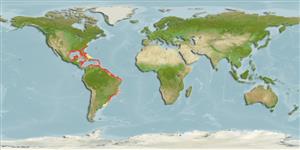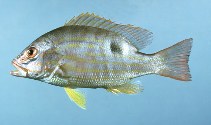Ajouter votre observation dans Fish Watcher
| Native range | All suitable habitat | Point map | Year 2050 |

|
| This map was computer-generated and has not yet been reviewed. |
| Lutjanus synagris AquaMaps Data sources: GBIF OBIS |
Brazil country information
Common names:
Areiacó, Areocó, Ariaco
Occurrence: native
Salinity: marine
Abundance: occasional (usually not seen) | Ref: Feitoza, B.M., R.S. Rosa and L.A. Rocha, 2005
Importance: commercial | Ref: Barreto, T.M.R.R., K.M.F. Freire, J.J.C. Reis-Júnior, L.C. Rosa, A. Carvalho-Filho and M.M. Rotundo, 2018
Aquaculture: | Ref:
Regulations: | Ref:
Uses: no uses
Comments: Ranges from Paraíba south to São Paulo, including Manuel Luiz Reefs and Zumbi Reefs (Ref. 57756); reported to reach the southernmost tip of the Bombinhas Peninsula, Santa Catarina (Ref. 55758). Also Ref. 55, 13442, 26938. Caught by shrimp trawl in Pirambu, Sergipe (Ref. 118626).
National Checklist:
Country Information: https://www.cia.gov/library/publications/resources/the-world-factbook/geos/br.html
National Fisheries Authority:
Occurrences: Occurrences Point map
Main Ref: Floeter, S.R., J.L. Gasparini, L.A. Rocha, C.E.L. Ferreira, C.A. Rangel and B.M. Feitoza, 2003
National Database:
Occurrence: native
Salinity: marine
Abundance: occasional (usually not seen) | Ref: Feitoza, B.M., R.S. Rosa and L.A. Rocha, 2005
Importance: commercial | Ref: Barreto, T.M.R.R., K.M.F. Freire, J.J.C. Reis-Júnior, L.C. Rosa, A. Carvalho-Filho and M.M. Rotundo, 2018
Aquaculture: | Ref:
Regulations: | Ref:
Uses: no uses
Comments: Ranges from Paraíba south to São Paulo, including Manuel Luiz Reefs and Zumbi Reefs (Ref. 57756); reported to reach the southernmost tip of the Bombinhas Peninsula, Santa Catarina (Ref. 55758). Also Ref. 55, 13442, 26938. Caught by shrimp trawl in Pirambu, Sergipe (Ref. 118626).
National Checklist:
Country Information: https://www.cia.gov/library/publications/resources/the-world-factbook/geos/br.html
National Fisheries Authority:
Occurrences: Occurrences Point map
Main Ref: Floeter, S.R., J.L. Gasparini, L.A. Rocha, C.E.L. Ferreira, C.A. Rangel and B.M. Feitoza, 2003
National Database:
Common names from other countries
Classification / Names Noms communs | Synonymes | Catalog of Fishes(Genre, Espèce) | ITIS | CoL | WoRMS | Cloffa
> Eupercaria/misc (Various families in series Eupercaria) > Lutjanidae (Snappers) > Lutjaninae
Etymology: Lutjanus: Malay, ikan lutjan, name of a fish.
More on author: Linnaeus.
Etymology: Lutjanus: Malay, ikan lutjan, name of a fish.
More on author: Linnaeus.
Environment: milieu / climate zone / depth range / distribution range Écologie
marin récifal; profondeur 10 - 400 m (Ref. 9626), usually 21 - 70 m (Ref. 9626). Subtropical; 38°N - 38°S, 98°W - 31°W (Ref. 55253)
Distribution Pays | Zones FAO | Écosystèmes | Occurrences | Point map | Introductions | Faunafri
Western Atlantic: Bermuda (Anderson, pers. comm.) and North Carolina, USA to southeastern Brazil, including Gulf of Mexico and Caribbean Sea (Ref. 9626). Most abundant around the Antilles, on the Campeche Bank, off Panama and the northern coast of South America. Lutjanus ambiguus (Poey, 1860), an intergeneric hybrid with Ocyurus chrysurus (Bloch) as demonstrated by Loftus (1992: Ref. 33006), followed by McEachran &. Fechhelm (2005: Ref. 78464).
Length at first maturity / Taille / Poids / Âge
Maturity: Lm 23.4, range 16 - 21.5 cm
Max length : 60.0 cm TL mâle / non sexé; (Ref. 40637); common length : 25.0 cm TL mâle / non sexé; (Ref. 55); poids max. publié: 3.5 kg (Ref. 40637); âge max. reporté: 10 années (Ref. 3090)
Max length : 60.0 cm TL mâle / non sexé; (Ref. 40637); common length : 25.0 cm TL mâle / non sexé; (Ref. 55); poids max. publié: 3.5 kg (Ref. 40637); âge max. reporté: 10 années (Ref. 3090)
Description synthétique Clés d'identification | Morphologie | Morphométrie
Épines dorsales (Total) : 10; Rayons mous dorsaux (Total) : 12 - 13; Épines anales: 3; Rayons mous anaux: 8 - 9. Preopercular notch and knob weak. Pectoral fins short, not reaching level of anus. Scale rows on back rising obliquely above lateral line. Back and upper side pink to reddish, with a green tinge and diffused darker vertical bars. The lower sides and belly silvery with a yellow tinge. A series of 8 - 10 horizontal yellow or golden stripes on sides. A diffused black spot mainly above the lateral line and below the anterior portion of the soft dorsal-fin rays.
Adults are found over all types of bottom, but mainly around coral reefs and on vegetated sandy areas. In turbid as well as clear water (Ref. 9710). They often form large aggregations, especially during the breeding season. Feed at night on small fishes, bottom-living crabs, shrimps, worms, gastropods and cephalopods. Good food fish, it is marketed fresh.
Life cycle and mating behavior Maturité | Reproduction | Frai | Œufs | Fécondité | Larves
Often form large aggregations, especially during the breeding season.
Référence principale
Upload your references | Références | Coordinateur | Collaborateurs
Allen, G.R., 1985. FAO Species Catalogue. Vol. 6. Snappers of the world. An annotated and illustrated catalogue of lutjanid species known to date. FAO Fish. Synop. 125(6):208 p. Rome: FAO. (Ref. 55)
Statut dans la liste rouge de l'IUCN (Ref. 130435: Version 2024-2)
Quasi-menacé (NT) ; Date assessed: 10 October 2015
Utilisations par l'homme
Pêcheries: commercial; pêche sportive: oui; Aquarium: Aquariums publics
FAO(pêcheries: production; publication : search) | FishSource | Sea Around Us
Plus d'informations
Trophic ecology
Éléments du régime alimentaire
Composition du régime alimentaire
Consommation alimentaire
Food rations
Prédateurs
Éléments du régime alimentaire
Composition du régime alimentaire
Consommation alimentaire
Food rations
Prédateurs
Population dynamics
Paramètres de croissance
Max. ages / sizes
Length-weight rel.
Length-length rel.
Fréquences de longueurs
Mass conversion
Recrutement
Abondance
Paramètres de croissance
Max. ages / sizes
Length-weight rel.
Length-length rel.
Fréquences de longueurs
Mass conversion
Recrutement
Abondance
Life cycle
Reproduction
Maturité
Fécondité
Frai
Spawning aggregations
Œufs
Développement de l'œuf
Larves
Dynamique des populations larvaires
Reproduction
Maturité
Fécondité
Frai
Spawning aggregations
Œufs
Développement de l'œuf
Larves
Dynamique des populations larvaires
Anatomy
Surface branchiale
Brain
Otolith
Surface branchiale
Brain
Otolith
Physiology
Body composition
Nutrients
Consommation d'oxygène
Type de nage
Vitesse de nage
Visual pigments
Fish sound
Diseases & Parasites
Toxicity (LC50s)
Body composition
Nutrients
Consommation d'oxygène
Type de nage
Vitesse de nage
Visual pigments
Fish sound
Diseases & Parasites
Toxicity (LC50s)
Genetics
Génétique
Heterozygosity
Héritabilité
Génétique
Heterozygosity
Héritabilité
Human related
Aquaculture systems
Profils d'aquaculture
Souches
Ciguatera cases
Stamps, coins, misc.
Aquaculture systems
Profils d'aquaculture
Souches
Ciguatera cases
Stamps, coins, misc.
Outils
E-book | Guide de terrain | Clés d'identification | Générateur de fréquences de longueur | Outil de dynamique de population | Carte par point | Classification Tree
| Catch-MSY |
Articles particuliers
Télécharger en XML
Sources Internet
Aquatic Commons | BHL | Cloffa | Websites from users | FishWatcher | CISTI | Catalog of Fishes(Genre, Espèce) | DiscoverLife | ECOTOX | Faunafri | Fishtrace | GenBank(génôme, nucléotide) | GloBI | GOBASE | GoMexSI (interaction data) | | Google Books | Google Scholar | Google | IGFA World Record | MitoFish | Bases de données nationales | Otolith Atlas of Taiwan Fishes | Aquariums publics | PubMed | Reef Life Survey | Identification RFE | Scirus | SeaLifeBase | Arbre de Vie | Wikipedia(aller à, chercher) | World Records Freshwater Fishing | Zoological Record
Estimates based on models
Preferred temperature (Ref. 115969): 19.7 - 27.5, mean 24.7 (based on 260 cells).
Phylogenetic diversity index (Ref. 82804): PD50 = 0.5000 [Uniqueness, from 0.5 = low to 2.0 = high].
Bayesian length-weight: a=0.01514 (0.01359 - 0.01685), b=2.96 (2.94 - 2.98), in cm Total Length, based on LWR estimates for this species (Ref. 93245).
Niveau trophique (Ref. 69278): 3.8 ±0.2 se; based on diet studies.
Résilience (Ref. 120179): Milieu, temps minimum de doublement de population : 1,4 à 4,4 années (K=0.13-0.26; tm=2; tmax=10).
Prior r = 0.87, 95% CL = 0.57 - 1.30, Based on 6 data-limited stock assessments.
Fishing Vulnerability (Ref. 59153): Moderate vulnerability (37 of 100).
Climate Vulnerability (Ref. 125649): High to very high vulnerability (74 of 100).





